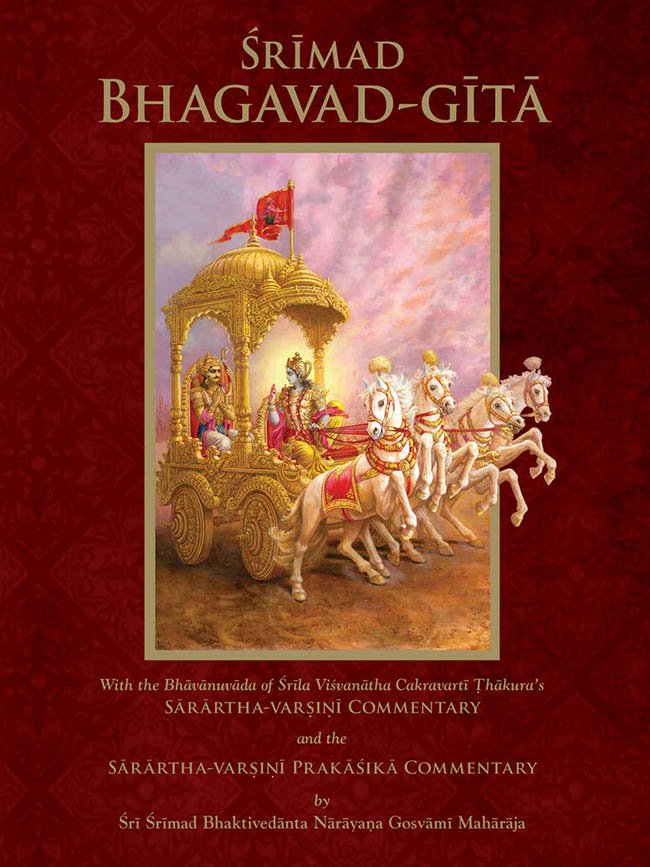Shrimad Bhagavad-gita
by Narayana Gosvami | 2013 | 327,105 words
The Bhagavad-gita Verse 7.29, English translation, including the Vaishnava commentaries Sarartha-varsini-tika, Prakashika-vritti and Rasika-ranjana (excerpts). This is verse 29 from the chapter 7 called “Vijnana-Yoga (Yoga through Realization of Transcendental Knowledge)”
Verse 7.29
Sanskrit text, Unicode transliteration, Word-for-word and English translation of verse 7.29:
जरा-मरण-मोक्षाय माम् आश्रित्य यतन्ति ये ।
ते ब्रह्म तद् विदुः कृत्स्नम् अध्यात्मं कर्म चाखिलम् ॥ २९ ॥jarā-maraṇa-mokṣāya mām āśritya yatanti ye |
te brahma tad viduḥ kṛtsnam adhyātmaṃ karma cākhilam || 29 ||jarā-maraṇa–from old age and death; mokṣāya–for deliverance; mām–of Me; āśritya–taking shelter; yatanti–endeavour; ye te–those who; brahma–spirit; tat–that (Supreme Personality); viduḥ–understand; kṛtsnam–in its entirety; adhyātmam–the nature of the jīvātmā; karma–fruitive action and its result in the form of material existence; ca–and; akhilam–the sum total.
Those who strive for liberation from old age and death by taking refuge of Me attain knowledge of brahma, awareness of the pure constitutional nature of the living entity, and an understanding of the principle of fruitive action, which is the cause of their bondage to the material world.
Commentary: Sārārtha-Varṣiṇī Ṭīkā
(By Śrīla Viśvanātha Cakravartī Ṭhākura; the innermost intention of the commentary named ‘the shower of essential meanings’)
Śrī Bhagavān said earlier that all sakāma-bhaktas, such as the distressed, become perfect by worshipping Him. Others, however, who worship the demigods, degrade themselves and remain in the material world. In saying this, Bhagavān is also referring to those who are unqualified to perform worship of Him.
Here, in this verse beginning with jarā, Śrī Bhagavān is speaking about the fourth type of sakāma-bhakta. “Those yogīs who endeavour to stop the cycle of old age and death and who worship Me with a desire for liberation are, by the influence of My bhakti, eventually able to attain full understanding of brahma (that is, My eternal, beautiful Śyāmasundara form), adhyātmā (the self, or the jīva who possesses a body and exists in it as an enjoyer) and the principle of karma (how the living entities enter this material world).”
Commentary: Sārārtha-Varṣiṇī Prakāśikā-vṛtti
(By Śrīla Bhaktivedānta Nārāyaṇa Gosvāmī Mahārāja; the explanation that illuminates the commentary named Sārārtha-varṣiṇī)
Bhagavān first explained the first three types of sakāma-bhaktas, such as the distressed. “They initially worship Me in order to attain their desired goals. After they have attained these goals and understood that such aims are actually miserable and degrading, they become detached from them. Finally, by attaining sādhu-saṅga, they become successful and attain My one-pointed devotional service, or aikāntikī-bhakti.” In the present verse, Bhagavān is explaining the fourth type of bhakta, namely the sakāma-bhakta, who desires mokṣa. “When such sakāma-bhaktas achieve the association of My pure devotees, they lose their desire to merge with brahma and focus on becoming situated in their pure constitutional form as the servants of Bhagavān. These sakāma-jñānī-bhaktas are real mumukṣus, seekers of liberation. Only such brahmabhūta-jñānī-bhaktas (who have attained the nature of brahma) completely understand brahma-tattva, adhyātma-tattva (the living entity) and karma-tattva and attain pure devotion.”
